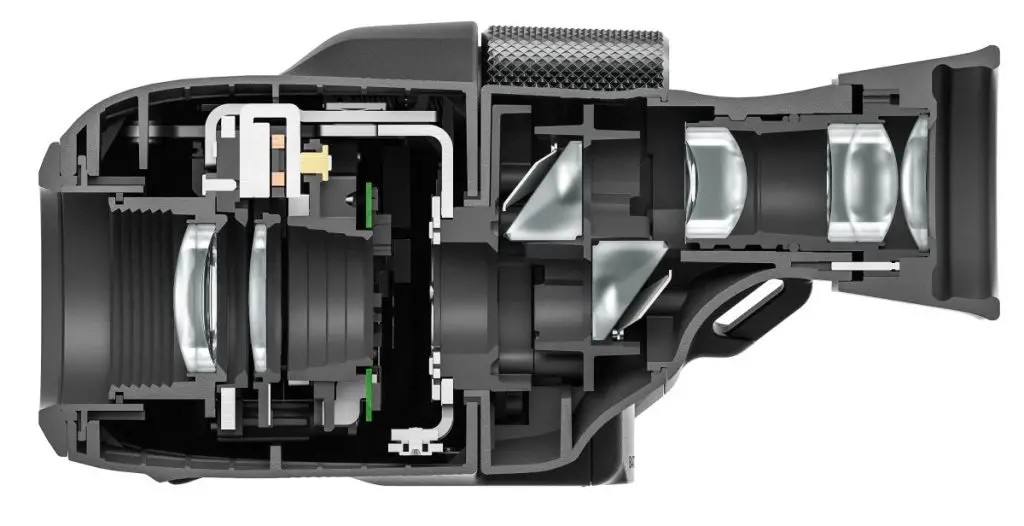Are Image Stabilizing Binoculars Worth It?
Traditional binoculars have one significant drawback – they require a steady hand to avoid image shake or blurring.
This problem is particularly pronounced at high magnification levels or when the user is holding the binoculars for an extended period.
In response, manufacturers have introduced image-stabilizing binoculars. These specialized binoculars use advanced technology to counteract hand-shake and produce a clearer, more stable image.

Quick Answer: If someone frequently engages in activities such as birdwatching, boating, hiking, hunting, or attending concerts, image-stabilizing binoculars can significantly enhance their viewing experience. In these scenarios, the benefits may outweigh the costs. However, for those who only occasionally use binoculars or have a limited budget, traditional binoculars may suffice.
In this write-up, we will explore the different aspects of image-stabilizing binoculars and why they may be worth the investment.
Let’s first start with how image stabilization binoculars work, Their advantages and disadvantages.
How Do Image Stabilizing Binoculars Work?
Well, image-stabilizing binoculars use a combination of technology and clever engineering to provide a stable and clear image, even when you’re moving around.
At the heart of the system are gyroscopes and accelerometers, which detect any movement of the binoculars and then adjust the optical components to compensate for it. This can involve shifting the angle of prisms inside the binoculars or using digital processing software to stabilize the image.
The result is a much more stable and clear image, even when using high magnification or in situations where there is a lot of movement. So, whether you’re birdwatching, hiking, or watching a concert, image-stabilizing binoculars can significantly enhance your viewing experience.
Of course, the effectiveness of the system can vary depending on the quality of the binoculars, but in general, image stabilization is an impressive feat of engineering that can make a real difference.

Image Credit: Canon, Canon IS Cutaway Diagram
Advantages of Image-Stabilizing Binocular
Shaky Images No More
One of the primary advantages of image-stabilizing binoculars is the reduction of hand-shake.
The technology in these binoculars is designed to detect and counteract small movements caused by hand tremors, breathing, or other external factors.
This feature allows users to enjoy a stable, shake-free image, even at high magnification levels. It also reduces eye strain and fatigue, as the user does not need to strain to hold the binoculars steady.
Image-stabilizing binoculars are particularly useful for outdoor activities that involve a lot of movement, such as hiking, boating, or hunting.
They allow users to observe wildlife, scenery, or other objects with greater detail and clarity, without worrying about image shake or blur.
Enhance Your Viewing Experience
Image-stabilizing binoculars also produce a clearer image compared to traditional binoculars.
The technology in these binoculars compensates for hand-shake by adjusting the position of the lenses or the image sensor.
This adjustment results in a sharper, clearer image, even under challenging lighting conditions or when viewing distant objects.
The quality of the image produced by image-stabilizing binoculars is particularly noticeable when compared to traditional binoculars.
The latter often produces a blurry or shaky image, particularly at high magnification levels or in low-light conditions.
In contrast, image-stabilizing binoculars produce a stable, clear image, making them ideal for activities that require detailed observation, such as bird watching or astronomy.
Zoom In and See It All
Another advantage of image-stabilizing binoculars is their ability to offer greater magnification. Traditional binoculars are limited in their magnification by the user’s ability to hold them steady.
At higher magnification levels, even small hand movements can result in a shaky or blurred image.
Image-stabilizing binoculars can offer significantly higher magnification levels, up to 18X or Even 20X.
This greater magnification allows users to observe distant objects with greater detail and clarity, such as wildlife, celestial objects, or landscape features.
The Zeiss 20×60 T* S Image Stabilised Binoculars
If you’re looking for the ultimate magnification experience with image-stabilizing binoculars, then I have found this Zeiss 20x model.
With this model, you won’t have to worry about a blurry or shaky image anymore. All you have to do is press a button, and the image will be mechanically stabilized at 20x, providing a clear and steady view.
These binoculars also come with a 60mm objective lens diameter, ensuring a bright and vivid image that makes every detail visible.
Moreover, they have robust mechanics, making them durable and resistant to damage.
With the expertise of Zeiss, a company with years of experience in manufacturing top-quality binoculars, you can be sure of great optics that will take your viewing experience to the next level.
The only con is that they are very heavily priced.
- Made in Germany
- 20x magnification with image stabilizing gyro provides shake-free long distance viewing
- Premium lens coatings and high-performance optical glass for bright and razor-sharp image quality
Stay Focused Longer: Extended Viewing Duration
Image-stabilizing binoculars also allow for extended viewing durations.
Holding traditional binoculars steady for an extended period can be tiring and lead to muscle fatigue or cramps.
In contrast, image-stabilizing binoculars require less effort to hold steady, allowing users to observe objects for longer periods comfortably.
Extended viewing duration is particularly important for outdoor activities that involve observing wildlife or landscapes.
It allows users to take in their surroundings fully and appreciate the details and beauty of the environment. It also enhances the user’s overall experience and reduces the risk of missing critical moments or details.
| Aspect | Image-Stabilizing Binoculars | Traditional Binoculars |
|---|---|---|
| Optical Quality | Superior image stabilization | Optics may produce image shake |
| Price Range | Higher cost | Lower cost |
| Ease of Use | Require power source and learning curve | Easy to use without additional equipment |
| Portability | Heavier and bulkier | Lighter and more portable |
Disadvantages of Image-Stabilizing Binoculars
Image-stabilizing binoculars offer several advantages over traditional binoculars, including reduced hand-shake, clearer images, greater magnification, and extended viewing duration.
However, these advanced features come with a few drawbacks that potential buyers should consider before making a purchase.
Here, we will explore the disadvantages of image-stabilizing binoculars and why they may not be the best choice for everyone.
Cost Factor
One significant disadvantage of image-stabilizing binoculars is their cost.
These specialized binoculars are significantly more expensive than traditional binoculars, with prices ranging from several hundred to several thousand dollars.
The technology used in image-stabilizing binoculars is complex and requires specialized equipment and expertise to manufacture.
This complexity contributes to the high cost of these binoculars, making them inaccessible to many users.
Power Supply
Another disadvantage of image-stabilizing binoculars is their power supply requirements.
The technology used in these binoculars requires a power source, either in the form of batteries or rechargeable cells.
The need for a power source adds to the weight and bulkiness of image-stabilizing binoculars, making them less portable and more challenging to use for extended periods.
Users need to carry spare batteries or charging equipment, adding to the overall cost and weight of the binoculars.
Weight and Bulkiness
Image-stabilizing binoculars are also typically heavier and bulkier than traditional binoculars. The added weight and bulk make them less portable and more challenging to use for extended periods.
The increased weight can also cause muscle fatigue or strain, particularly when holding the binoculars at arm’s length or when using them for extended periods.
This weight can be a particular problem for activities such as hiking or mountaineering, where users need to carry other equipment and supplies.
Learning Curve
Finally, another disadvantage of image-stabilizing binoculars is the learning curve required to use them effectively. The technology used in these binoculars is complex and requires some training to operate correctly.
Users need to learn how to adjust the settings and controls to compensate for hand-shake and other factors. This learning curve can be particularly steep for users who are not familiar with the technology or who have not used binoculars before.
| Pros/Image Stabilized Binoculars | Cons/Image Stabilized Binoculars |
|---|---|
| Reduction of hand-shake | Higher cost |
| Clearer image | Require power source |
| Greater magnification | Heavier and bulkier |
| Extended viewing duration | Learning curve |
Who makes the Best Image-Stabilized binoculars?
Several companies manufacture image-stabilizing binoculars, but some of the most reputable and well-known brands include Canon, Nikon, Fujinon, and Zeiss.
We have done some full reviews on Canon Image Stabilized binoculars.
You can Check:
These brands have established themselves in the market by producing high-quality binoculars with image stabilization technology.
Each brand offers various models with different specifications and features to cater to different needs and budgets.
It’s always a good idea to research and compare different brands and models before making a purchase to ensure you find the one that best suits your needs.
An Interesting Video About IS Technology
Who can Benefit from Image-Stabilizing Binoculars?
Image-stabilizing binoculars may not be the right choice for everyone, but there are specific groups of people who can benefit significantly from this technology.
In this section, we will explore who can benefit the most from image-stabilizing binoculars.
Birdwatchers
Birdwatchers can significantly benefit from image-stabilizing binoculars, particularly when trying to spot birds that are small and move quickly.
The technology used in image-stabilizing binoculars reduces hand-shake, making it easier to spot and follow birds as they move.
The greater magnification offered by these binoculars also makes it easier to identify bird species and observe them in more detail.
Birdwatchers who spend long periods observing birds can also benefit from the extended viewing duration offered by image-stabilizing binoculars.

Stargazing & Astronomy
When stargazing, it’s common to use high-magnification binoculars to get a closer look at the stars, planets, and other celestial objects.
However, these high magnifications can also make it more challenging to maintain a steady image, especially if you’re using a handheld pair of binoculars.
Image-stabilizing binoculars help to reduce or eliminate hand-shake and vibration, making it easier to maintain a clear and stable image, even when using high magnification.
This means that stargazers can see the details of stars, planets, and other celestial objects more clearly and for more extended periods without experiencing eye strain or fatigue.
Boaters
Boaters can also benefit from image-stabilizing binoculars, particularly when trying to spot landmarks or other boats at a distance.
The technology used in these binoculars reduces the impact of boat movement, making it easier to spot and track objects even in choppy waters.
The greater magnification offered by image-stabilizing binoculars also makes it easier to identify landmarks or other boats in the distance.
Boaters who spend extended periods on the water can benefit from the extended viewing duration offered by these binoculars.
Hikers and Mountaineers
Hikers and mountaineers can also benefit from image-stabilizing binoculars, particularly when trying to spot landmarks or wildlife in the distance.
The technology used in these binoculars reduces hand-shake, making it easier to spot and track objects, even when moving or in windy conditions.
The greater magnification offered by these binoculars also makes it easier to identify landmarks or wildlife in the distance.
Hikers and mountaineers who spend extended periods outdoors can benefit from the extended viewing duration offered by image-stabilizing binoculars.
Hunters
Hunters can also benefit from image-stabilizing binoculars, particularly when trying to spot and track game animals.
The technology used in these binoculars reduces hand-shake, making it easier to spot and track animals, even in low light conditions or when moving.
The greater magnification offered by these binoculars also makes it easier to identify game animals and observe them in more detail.
Hunters who spend long periods in the field can benefit from the extended viewing duration offered by image-stabilizing binoculars.
Concert-goers
Finally, concert-goers can also benefit from image-stabilizing binoculars, particularly when trying to spot performers on stage.
The technology used in these binoculars reduces hand-shake, making it easier to spot and track performers, even from a distance.
The greater magnification offered by these binoculars also makes it easier to see performers on stage and observe their movements and expressions.
Concert-goers who spend long periods at concerts can benefit from the extended viewing duration offered by image-stabilizing binoculars.
Comparison with Traditional Binoculars
When considering whether to invest in image-stabilizing binoculars, it is helpful to compare them to traditional binoculars.
In this section, we will explore how image-stabilizing binoculars compare to traditional binoculars in terms of optical quality, price range, ease of use, and portability.
Optical Quality
Optical quality is an essential factor to consider when choosing binoculars.
Traditional binoculars offer high-quality optics that can provide sharp, clear images.
However, hand-shake can be a significant problem when using traditional binoculars, especially at higher magnifications.
Image-stabilizing binoculars offer superior image stability, making it easier to see details and track objects, even at high magnifications.
This technology can significantly enhance the optical quality of binoculars and provide a better viewing experience.
Price Range
Price is another significant factor to consider when choosing binoculars.
Traditional binoculars are available in a wide range of prices, from less than $50 to over $1,000.
Image-stabilizing binoculars tend to be more expensive than traditional binoculars, with prices ranging from $200 to $2,000 or more.
However, the technology used in image-stabilizing binoculars can provide significant benefits, making the higher cost worth it for some users.
Ease of Use
Ease of use is an essential factor to consider when choosing binoculars, especially for beginners.
Traditional binoculars are relatively easy to use, with simple focusing mechanisms and no need for additional power sources.
Image-stabilizing binoculars require a power source, usually in the form of batteries, and may have more complex focusing mechanisms or additional buttons to control the stabilization feature.
This added complexity can make image-stabilizing binoculars more challenging to use, especially for beginners.
However, with practice, users can become accustomed to the additional features and find the binoculars easier to use.
Portability
Portability is an essential factor to consider when choosing binoculars, especially for outdoor activities. Traditional binoculars tend to be more compact and lightweight than image-stabilizing binoculars.
Image-stabilizing binoculars may be bulkier and heavier due to the additional technology and power source.
This can make them more challenging to carry on long hikes or backpacking trips.
However, some manufacturers have produced more compact and lightweight image-stabilizing binoculars, making them more portable for outdoor activities.
Conclusion: Are Image-Stabilizing Binoculars Worth the Cost?
In conclusion, image-stabilizing binoculars can offer significant advantages over traditional binoculars, including improved image stability, clearer images, greater magnification, and extended viewing duration. However, they also come with some disadvantages, such as a higher cost, power supply requirements, weight and bulkiness, and a learning curve.
For birdwatchers, boaters, hikers, mountaineers, hunters, and concert-goers, image-stabilizing binoculars can be an excellent investment. They can provide better image stability and magnification, making it easier to see details and track objects in motion.
If image stability and magnification are crucial, then image-stabilizing binoculars may be the better option. However, if portability and ease of use are more important, traditional binoculars may be a better fit.
In conclusion, the value of image-stabilizing binoculars ultimately depends on the user’s needs and usage conditions.
While they may be more expensive and come with a learning curve, they can offer significant benefits in terms of image stability and magnification.
Therefore, for those who prioritize these features in their binoculars, image-stabilizing binoculars may be worth the investment.
Last update on 2024-04-27


